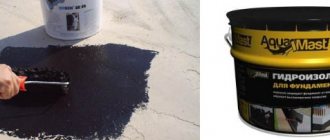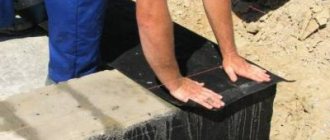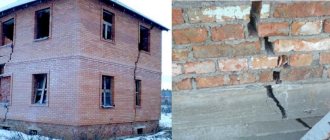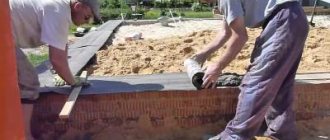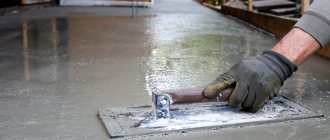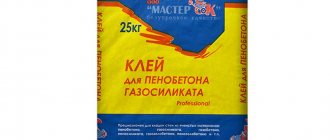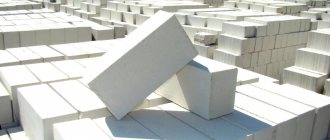Bitumen primer is a two-component substance, which includes bitumen mastic and solvent. Essentially, a primer is a primer solution used to create a strong bond between the mastic and the foundation.
Since the primer is more liquid than the waterproofing coating itself, it penetrates better into the concrete layer and forms a highly adhesive film on the working surface. In construction, primers are successfully used for priming surfaces before applying bitumen, polymer and any other built-up and rolled waterproofing materials.
Why prime the foundation?
Applying a primer
Primer - or in a more well-known definition, primer - is first applied to surfaces in order to prepare them for the installation of a waterproofing coating. The hygroscopicity of the foundation slab is due to the porosity of the material from which the foundation is made. Since most foundations are structures made of precast or monolithic concrete, bitumen mastics are widely used as waterproofing.
They are practical to use and exhibit excellent performance, but the main thing is that a master of any qualification can apply coating waterproofing.
Before applying waterproofing, the working surface is thoroughly cleaned of dust and dried. If necessary, due to the high porosity of the material, the primer solution is applied in two to three layers. For convenience, you should prime only that part of the structure to which the coating will be applied. It is recommended to carry out all subsequent work after the primer has completely dried.
Bitumen primer
Priming the surface with various compositions is recommended to improve the adhesion of the base material and the working surface. The inappropriateness of priming the foundation before applying bitumen or polymer waterproofing is a common misconception. Coating primed surfaces allows you to speed up the process of installing waterproofing and save coating mastic due to preliminary impregnation of the concrete stone with a low-concentrated coating solution with a high degree of absorption. You need to choose a primer in accordance with the type of main waterproofing material.
Removing bitumen
Treating them with white spirit, turpentine or any other organic solvent helps to wash off the remnants of bitumen or bitumen-polymer primer from tools.
A simple tip - on the container with the primer you can see the composition and list of liquids with which it is recommended to dilute it, if required by the application technology. These compounds are recommended for removal.
If you need to clean accidentally formed smudges or splashes of bitumen from the surface, then the sooner you tackle this issue, the better - fresh stains can be cleaned without the use of chemicals. For example, you can remove bitumen primer from concrete or cement screed with a scraper or other sharp, flat tool.
Removing old bitumen stains is possible using special gel compositions, which can be applied to most types of bitumen primers without damaging the surface.
What is the difference between bitumen primer and bitumen mastic?
Is it possible to replace one composition with another? A very similar set of components and appearance sometimes mislead the inexperienced consumer. Both liquids are dark, viscous, and are produced on the basis of bitumen, which acts as a binder with the addition of polymers and minerals. Both products are used at the waterproofing stage, however, they have a different set of basic characteristics and, accordingly, different purposes.
A primer is a multi-component primer that improves adhesion with a subsequent layer of waterproofing, penetrating deeply into the base and improving its water-repellent properties. Priming is also often used for anti-corrosion surface treatment. The primer can be used in the cold season, with high humidity; it dries faster than mastic, on average 2-4 times.
The main task of the primer is to ensure the absolute waterproofness of the preparatory layer, filling all the unevenness and cracks of the base.
Mastic is a composition with a wider range of applications, the main of which are: direct waterproofing of surfaces made of concrete, reinforced concrete, metal or wood, gluing tiles or roofing felt on the roof, insulation of swimming pools and wells. Mastic should only be used on a completely dry base in warm weather.
Ideally, both products are used sequentially, first priming the building surface, then waterproofing with mastic, thus providing reliable protection against moisture and corrosion.
Types of primer
The primer is an integral part of the waterproofing coating, so before purchasing a batch of primer, you must make sure that the combined action of the two materials will not lead to a physical and chemical conflict. The ideal option for implementing a primer-mastic combination is the use of materials with similar composition and characteristics.
Usually, the same coating, largely diluted with a solvent, is used as a primer for bitumen mastic. Emulsions, acetate destructors or gasoline are used as solvents. Ready-made primers are created on an industrial scale and are low-concentrated bitumen mastic with an emulsifier.
In addition to the bitumen base, there are various acrylic and polymer primers that can also be used to strengthen the foundation surface before coating. There are several types of primer, depending on the coating material and solvent used:
- ready mixtures:
- by type of mastic: bitumen, acrylic, polymer;
- by type of solvent: acetate, gasoline, emulsion;
- prepared mixtures.
The most popular type of mastic is bitumen.
Price fluctuations in the primer market are determined by the quality of the mixture, as well as the cost of the original components. Making your own primer often means saving on quality rather than the cost of the final product. Only an experienced builder can correctly maintain the proportions, select non-conflicting components and mix a homogeneous solution. The money saved is insignificant and not worth the effort.
For the average person, it is preferable to purchase a ready-made mixture in accordance with the recommendation of the manager of the construction company from which the waterproofing material will be purchased.
Standards of use
The consumption rate of bitumen primer per 1 m2 was mentioned above, but to achieve a positive result it is also important to know the technology of the work. The mixture is applied to cement-sand, concrete and other rough surfaces
If we are talking about a porous, dusty and uneven surface, then the treatment must be carried out using a brush or nylon brush. This application technology provides excellent impregnation of the base and high adhesion rates.
Surface priming allows you to increase the service life of materials. If there is a need to glue roll materials using a primer, the surface of reinforced concrete and concrete slabs, as well as the seams between the elements, must be primed. Each subsequent layer of rolled material is glued 4 hours after installation of the previous one. Rolled materials must be laid with an overlap, the width of which is 100 millimeters. In this case, cross-gluing should be avoided. Once the web is in place, it should be rolled with a special-purpose cylindrical roller.
Tools and materials used
Regardless of the choice of one or another type of primer, for preliminary preparation and subsequent application of waterproofing to the work surface, you may need the following equipment and materials:
- spatula or trowel;
- hammer, pickaxe;
- material for sealing joints - cement-sand mortar, polyurethane foam or putty;
- tools for preliminary cleaning of the primed surface: brushes, coarse dense cloth;
- container for calibrating the primer solution;
- wide brush or rough roller;
- primer
Uniform for working with mastic
In addition, you should use protective equipment (overalls, headgear, closed tight shoes), since the primer is a bitumen mixture that is difficult to remove from clothing and skin.
Before directly applying the primer, the initial cycle should be carried out, without which the priming process will lose all meaning.
Execution of work
The technology for waterproofing a foundation with a primer is quite simple and consists of several steps:
- Prepare the primer - mix the prepared solution thoroughly, dilute the concentrated primer, according to the instructions, with a suitable solvent;
- Pour the liquid into a convenient container and, using a wide brush or roller, apply an even layer to the cleaned surface;
- Wait the required time for the surface to dry completely and cover the base with the next layer of primer.
It is recommended to carry out foundation treatment work at a temperature not lower than -15 degrees Celsius.
When treating the base with a bitumen primer, you should be attentive to your own safety: during work, you must wear a mask and goggles to protect your mucous membranes from toxic fumes, as well as thick clothing that minimizes the possibility of bitumen getting on your bare skin.
Surface preparation
The primer should only be applied to a dry and dust-free surface. In addition, before priming, seams should be sealed, irregularities and protrusions should be eliminated, for better adhesion and uniform distribution of the waterproofing layer. Expansion joints should be filled with polyurethane foam, since rigid sealing of such units is excluded. Protrusions and local layers of concrete larger than a centimeter should be removed using a hammer or pick. Concrete unevenness caused by bulging formwork or poor-quality joining of prefabricated elements should be filled with leveling mortar. Watch the video on how to prime a foundation.
These actions are especially relevant when installing waterproofing using rolled and weld-on materials in order to ensure the future integrity of the waterproofing layer and prevent ruptures at points of increased stress in the sheet.
After the sealed joints have hardened, you can begin to remove dust and apply a primer. Further actions are carried out only on the condition that all preparatory work has been completed properly and the surface has been primed in two to three layers, depending on the degree of porosity of the working surface.
Technical properties
Bitumen primers "TechnoNIKOL" series 01
very often used for concrete surfaces and have the following technical parameters:
Main element: petroleum bitumen.
Percentage of non-volatile elements: 45-55
.
Temperature range for softening the composition: not less than 70 degrees
.
Material viscosity: 15-40
.
Operating temperature range: -20/+40 degrees
.
Setting time at an average temperature of +20 degrees
: till
12 o'clock
.
The manufacturer strictly controls all manufacturing processes, thanks to which the products precisely meet the requirements of GOST
requirements for this type of building materials.
Primer application technology
A primer is an ordinary primer with a special composition, so the technology for applying it is simple and straightforward. Regardless of the type of material chosen, the following steps should be taken to coat the foundation with a bitumen primer:
- stir the finished mixture or prepare a small amount of primer yourself in an easily transportable container;
- Apply the first layer of primer evenly to a surface cleaned of dust and moisture;
- wait for the first grip to dry and begin applying a layer of waterproofing on the next section of the foundation;
- after the first layer of primer has partially dried, apply a second layer, evenly distributing the solution;
- wait for the primer layer to dry completely in accordance with the period indicated by the manufacturer on the packaging.
Foundation primer must be applied in accordance with safety regulations. You should avoid getting the solution on exposed parts of the body - otherwise you need to remove the primer as quickly as possible using a solvent or regular soap before the substance polymerizes. Watch the video on how to properly prepare the primer for use.
It is also recommended to use protective masks, since bitumen primers are quite toxic, and due to the presence of a solvent and various dryers in the composition, the primer quickly polymerizes with a massive release of harmful substances into the atmosphere. It is especially not recommended to work with primer indoors without special personal protective equipment. Upon completion of work, clean the tools with solvent.
DIY making
There are low-quality products on the construction market that are produced with deviations from technology. As a result, the primer takes a long time to dry or does not set at all. The surface remains damp and is not suitable for gluing the following materials.
The process of making bitumen primer yourself:
- prepare unleaded gasoline (1 kg);
- bitumen is melted in a container with a blowtorch or on a stove until it turns into a liquid state;
- cool the melt to a temperature of +80°C;
- melted resin is mixed into a container with gasoline in small portions (if added immediately, the gasoline will ignite);
- the resulting mixture is passed through a metal sieve.
Unleaded gasoline does not contain lead additives, which ensures its environmental friendliness. In Russia, gas stations sell only these types.
Calculation of primer volume
Based on the area of the surfaces to be treated, it is easy to calculate the required amount of primer. For ready-made mixtures, the material consumption per unit area is indicated on the packaging, taking into account the initial concentration. It is not recommended to further dilute factory mixtures, since the quality of the primer may deteriorate, and a conflict between the components being mixed is quite possible. The average consumption of bitumen primer is 0.5 liters per 1 m2.
If you are preparing the primer directly at the construction site, you should buy coating material with the expectation of using part of the coating to make the primer. Processing with such a mixture is not recommended for novice craftsmen.
In addition to the indicated consumption, to calculate the amount of the finished mixture, the number of layers applied should be taken into account. In the case of applying more than one layer of primer, the volume of the composition should be increased in an amount that is a multiple of the number of layers applied. For mixtures prepared by hand, it is difficult to calculate the required volume of primer, since the consumption will depend on the consistency of the primer.
Price
The price of a bitumen primer depends mainly on the degree of its concentration. The cost of the most popular varieties of this primer in non-professional work varies within the following limits:
- from 86 to 1,704 rubles per 20-liter bucket for bitumen “No. 01”;
- from 158 to 3151 rubles for a 20 liter volume for a universal polymer “No. 03”;
- from 65 to 1297 rubles for a 20 liter packaging bucket for inorganic emulsion “No. 04”.
bitumen primer “ AquaMast , which, unlike an emulsion, has a higher content of organics and solvents, varies from 67 to 1203 rubles.
But the bitumen primer produced under this trade designation has a different volume. “AquaMast” is sold in buckets of 18 liters rather than 20 liters. This type of bitumen also has the highest consumption - from 0.350 to 0.400 liters per square meter.
In general, this type of waterproofing primer is both the least expensive and the most reliable today. We should also not forget about such advantages as ease of use and high adhesion to any surface that is difficult for most products.

